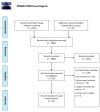Changing Primary School Children's Engagement in Active School Travel Using Safe Routes to School Interventions: A Rapid Realist Review
- PMID: 36011609
- PMCID: PMC9408451
- DOI: 10.3390/ijerph19169976
Changing Primary School Children's Engagement in Active School Travel Using Safe Routes to School Interventions: A Rapid Realist Review
Abstract
Safe Routes to School (SR2S) interventions have been implemented in many economically developed countries to improve children's engagement in Active School Travel (AST). Evaluations have highlighted inconsistencies in SR2S intervention outcomes, raising questions as to how, why, and under what contextual conditions these interventions work. This review used a Rapid Realist Review (RRR) methodology to build, test, and refine an overarching program theory that unpicks the contextual factors and underlying mechanisms influencing children's engagement in AST. From the 45 included documents, 16 refined Context-Mechanism-Outcome Configurations (CMOCs) were developed and clustered into three partial program theories (i.e., implementor/implementation, child, and parent), with the associated mechanisms of: (1) School Reliance; (2) School Priority; (3) Fun; (4) Pride; (5) Perceived Safety; (6) Distrust; (7) Convenience; (8) Perceived Capabilities; and (9) Reassurance. The overarching program theory delineates the pathways between intervention implementation, children's motivation, parental decision-making, and children's engagement in AST. The findings suggest SR2S interventions can motivate children to engage in AST, but whether this motivation is translated into engagement is determined by parental decision-making. This review is novel for highlighting that many of the factors influencing parental decision-making are contextually driven and appear to be unaddressed by the current suite of SR2S intervention strategies. The review additionally highlights the complexity of parental perceptions of safety, with the traffic and the road environment shaping only part of this multidimensional mechanism. Practitioners and policymakers need to tailor SR2S interventions to local contexts to better influence parental decision-making for children's engagement in AST.
Keywords: Active School Travel; Rapid Realist Review; Safe Routes to School; active school transportation; children; interventions; physical activity.
Conflict of interest statement
The authors declare no conflict of interest.
Figures
Similar articles
-
Reliability assessment of the 'field audit for children's active transport routes to school' (FACTS) tool.BMC Public Health. 2024 Oct 14;24(1):2812. doi: 10.1186/s12889-024-20285-3. BMC Public Health. 2024. PMID: 39402555 Free PMC article.
-
Understanding child and parent perceptions of barriers influencing children's active school travel.BMC Public Health. 2018 Aug 22;18(1):1053. doi: 10.1186/s12889-018-5874-y. BMC Public Health. 2018. PMID: 30134889 Free PMC article.
-
Evaluation of the California Safe Routes to School legislation: urban form changes and children's active transportation to school.Am J Prev Med. 2005 Feb;28(2 Suppl 2):134-40. doi: 10.1016/j.amepre.2004.10.026. Am J Prev Med. 2005. PMID: 15694521
-
The decline in active school transportation (AST): A systematic review of the factors related to AST and changes in school transport over time in North America.Prev Med. 2018 Jun;111:314-322. doi: 10.1016/j.ypmed.2017.11.018. Epub 2017 Nov 16. Prev Med. 2018. PMID: 29155222
-
Perceived Safety Influencing Active Travel to School-A Built Environment Perspective.Int J Environ Res Public Health. 2023 Jan 6;20(2):1026. doi: 10.3390/ijerph20021026. Int J Environ Res Public Health. 2023. PMID: 36673781 Free PMC article. Review.
Cited by
-
Association between the Duration of the Active Commuting to and from School, and Cognitive Performance in Urban Portuguese Adolescents.Int J Environ Res Public Health. 2022 Nov 25;19(23):15692. doi: 10.3390/ijerph192315692. Int J Environ Res Public Health. 2022. PMID: 36497762 Free PMC article.
-
Children's active school transportation: an international scoping review of psychosocial factors.Syst Rev. 2024 Jan 30;13(1):47. doi: 10.1186/s13643-023-02414-y. Syst Rev. 2024. PMID: 38291491 Free PMC article.
-
Children's intervention participation is associated with more positive beliefs towards active school transportation among parents.Health Promot Int. 2023 Apr 1;38(2):daad016. doi: 10.1093/heapro/daad016. Health Promot Int. 2023. PMID: 36932992 Free PMC article.
-
Reliability assessment of the 'field audit for children's active transport routes to school' (FACTS) tool.BMC Public Health. 2024 Oct 14;24(1):2812. doi: 10.1186/s12889-024-20285-3. BMC Public Health. 2024. PMID: 39402555 Free PMC article.
References
-
- World Health Organisation Physical Activity Fact Sheet. 2020. [(accessed on 30 June 2022)]. Available online: https://www.who.int/news-room/fact-sheets/detail/physical-activity.
-
- World Health Organisation Global Recommendations on Physical Activity for Health. 2010. [(accessed on 16 March 2022)]. Available online: https://www.who.int/publications/i/item/9789241599979. - PubMed
-
- Aubert S., Barnes J., Abdeta C., Abi Nader P., Adeniyi A., Aguilar-Farias N., Andrade Tenesaca D., Bhawra J., Brazo-Sayavera J., Cardon G., et al. Global Matrix 3.0 Physical Activity Report Card Grades for Children and Youth: Results and Analysis from 49 Countries. J. Phys. Act. Health. 2018;15:251–273. doi: 10.1123/jpah.2018-0472. - DOI - PubMed
-
- Denstel K., Broyles S., Larouche R., Sarmiento O., Barreira T., Chaput J., Church T., Fogelholm M., Hu G., Kuriyan R., et al. Active School Transport and Weekday Physical Activity In 9–11-Year-Old Children from 12 Countries. Int. J. Obes. Suppl. 2015;5:100–106. doi: 10.1038/ijosup.2015.26. - DOI - PMC - PubMed
Publication types
MeSH terms
LinkOut - more resources
Full Text Sources




